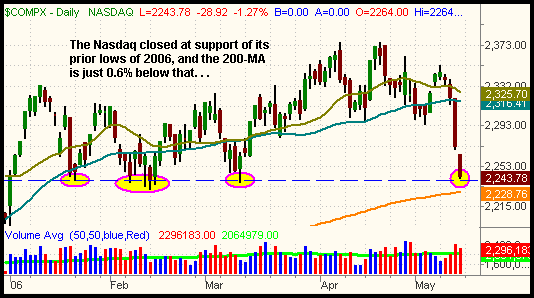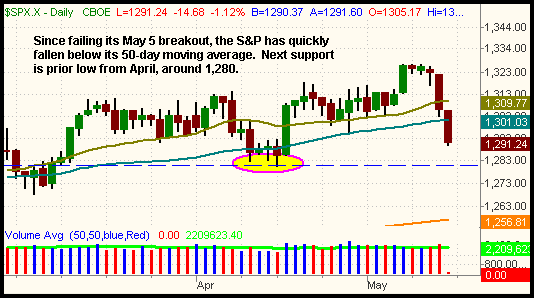The technical damage done by last Thursday's massive selloff sparked downside momentum that resulted in another round of significant losses in Friday's session. Small cap stocks took a beating again, as the Russell 2000 plunged 2.0%, bringing its two-day loss to 4.3%. The S&P Midcap 400, also a former broad market leader, fell 1.8%. The S&P 500, Nasdaq Composite, and Dow Jones Industrial Average lost 1.1%, 1.3%, and 1.0% respectively. Unlike a majority of the recent selloffs, the Dow failed to show relative strength this time. For the week, the Nasdaq Composite plummeted 4.2%, the S&P 500 lost 2.6%, and the Dow Jones Industrials slid 1.7%. Nearly all of those losses occurred in only the last two days.
Total volume in the NYSE was 1% higher than the previous day's level, but turnover in the Nasdaq declined by 8%. The losses on higher volume in the NYSE resulted in the S&P 500 registering its second consecutive "distribution day." The lighter volume in the Nasdaq prevented the index from having its fourth straight day of distribution, but the six confirmed days of institutional selling within the past four weeks has already led to a severely negative effect. Market internals in last Friday's session were quite ugly. In both exchanges, declining volume exceeded advancing volume by a ratio of approximately 5 to 1.
In the May 12 issue of The Wagner Daily, we mentioned that the Nasdaq was more likely to continue lower and test support of its prior lows from February and March than to reverse back up to resistance of its 50-day MA. However, we did not necessarily expect that to happen just one day later.

As the dashed horizontal line on the chart above illustrates, the Nasdaq finished the week right at support of its prior lows, which also happens to be the lowest level of the calendar year. The 200-day moving average, rising from below, is just 0.6% lower. Because the Nasdaq found support at this price level on three separate occasions earlier this year, the index could attempt to once again bounce off support at the 2,230 to 2,240 area. But even if it does, we would view any significant retracement as an opportunity to initiate new short positions in the sectors that have been showing the most relative weakness (semiconductors, networkers, internets, etc). If you are still long any positions that are under water, you should definitely consider selling them into any strength.
The daily chart of the S&P 500 is beginning to look a bit ominous. Only three days ago, the index was consolidating at a new five-year high that resulted from its May 5 breakout, but the breakout failed and now the index has fallen all the way back down below its 50-day moving average. As we mentioned last week, failed breakouts that occur after several months of sideways consolidations often lead to substantial downward momentum because the all the people who bought during the consolidation and the breakout become trapped and are forced to sell. This, in turn, attracts the short sellers as well. Such a chain of events is also the reason why stocks typically fall much faster than they go up. Next support for the S&P is the April low of 1,280. Resistance, of course, will be found all the way back up to the prior breakout level:

We have focused our commentary over the past two days more on the broad market action instead of individual sector performance because every sector we follow has shown substantial weakness since the May 11 selloff began. Even oil and gold stocks, two sectors that have been impervious to previous broad market corrections, have fallen along with the major indices. International ETFs, many of which have been outpacing the U.S. markets in recent months, have fallen substantially as well. Simply put, there has not been any clear sector leadership throughout the selloff, no place to hide. We will say, however, that we feel the S&P and Dow are likely to "catch up" with the relative weakness in the Nasdaq. Just as the Nasdaq closed at support of its prior lows, the Semiconductor Index ($SOX) closed at support of its 200-day MA on Friday. The combination of these two factors is likely to enable the Nasdaq to at least find temporary support. Conversely, both the S&P and Dow ! could fall further before running into any major support levels. Therefore, we are avoiding new short positions in the tech sectors right now (at least until the Nasdaq bounces) and instead looking for S&P and Dow sectors that have broken their uptrend lines and 50-day moving averages (many of them have). The short side of the Broker-Dealer Index ($XBD) has been working out well for us, but we would not enter new positions here if you missed it the first time we mentioned it. The oil-related ETFs (check out the ETF Roundup for a list) are looking interesting on the short side because several have failed their breakouts and are now showing major weakness. We remain short the S&P Select Energy SPDR (XLE), which is now showing a solid profit.
Hopefully you followed our advice to stay disciplined and quickly cut your losses if any positions hit their predefined stop prices. Now is a very bad time to fall into "hope" mode because overall conditions have rapidly become quite negative. There is never a guarantee that a bounce will come today just because stocks dropped a large percentage over the past two days. Obviously, a retracement will eventually come, but it might not happen until the broad market has fallen further. Therefore, capital preservation must be your number one priority right now.
Deron Wagner is the Founder and Head Trader of both Morpheus Capital LP, a U.S. hedge fund, and Morpheus Trading Group, a trader education firm launched in 2001 that provides daily technical analysis of the leading ETFs and stocks. For a free trial to the full version of The Wagner Daily or to learn about Wagner's other services, visit MorpheusTrading.com or send an e-mail to deron@morpheustrading.com.